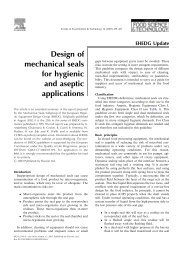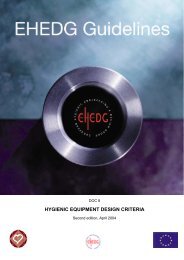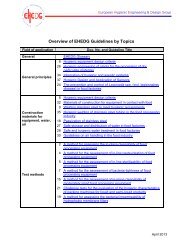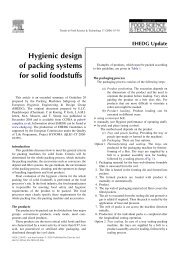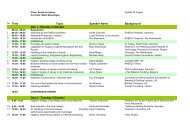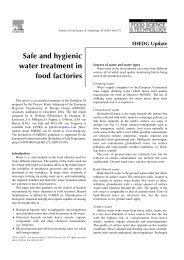Yearbook 2013/2014 - ehedg
Yearbook 2013/2014 - ehedg
Yearbook 2013/2014 - ehedg
You also want an ePaper? Increase the reach of your titles
YUMPU automatically turns print PDFs into web optimized ePapers that Google loves.
European Hygienic Engineering & Design Group<br />
Solving concrete kerb challenges to ensure hygiene and<br />
food safe wall protection in manufacturing environments<br />
Using chemical- and water-resistant polymer composite kerbs and plinths help ensure that food<br />
production facilities remain hygienic.<br />
Nick Van den Bosschelle, PolySto, Lokeren, Belgium, e-mail: nick@polysto.com, www.polysto.com<br />
For the past 25 years, sandwich panel constructions have<br />
been the most popular way to construct food safe rooms in<br />
Europe, because it offers fast installation, is easy to clean<br />
and provides good insulation value. Nevertheless, sandwich<br />
panels are very weak and quickly damaged. Often, kerbs in<br />
this scheme have been made onsite in the manufacturing<br />
plant during construction, composed of concrete and covered<br />
by the floor finishing. This system has some important<br />
disadvantages with regard to food safety, impact resistance<br />
and maintenance.<br />
Concrete covered by any kind of flooring material is never a<br />
monolithic system and after some period of time, the bonding<br />
between the concrete and the floor material will break as the<br />
concrete deteriorates due to exposure to humidity and acids<br />
in the air and other physical impacts to the surface. Physical<br />
impacts from trollies, forklifts, hand pallets and cleaning<br />
machines cause cracks to appear in the floor covering<br />
(Figures 1 and 2). The result is that dirt and cleaning water<br />
starts to leak through those cracks, building up behind the<br />
floor covering and absorbed by the concrete. This trapped<br />
dirty water will eventually begin to evaporate, creating a high<br />
pressure of humidity behind the floor covering. The pressure<br />
eventually breaks the bonding between the concrete and<br />
the floor finishing, exposing the concrete and creating food<br />
safety issues as dirt builds up in the resulting crevices and<br />
provides harbourage to harmful bacteria.<br />
Figures 1 and 2. Damaged concrete kerbs, as shown, create<br />
harbourage niches for dirt and bacteria in food processing<br />
environments.<br />
Figures 3 and 4. Kerbs and plinths for food safe environments.



